FORD F750 2001 10.G Owners Manual
Manufacturer: FORD, Model Year: 2001, Model line: F750, Model: FORD F750 2001 10.GPages: 240, PDF Size: 1.3 MB
Page 211 of 240
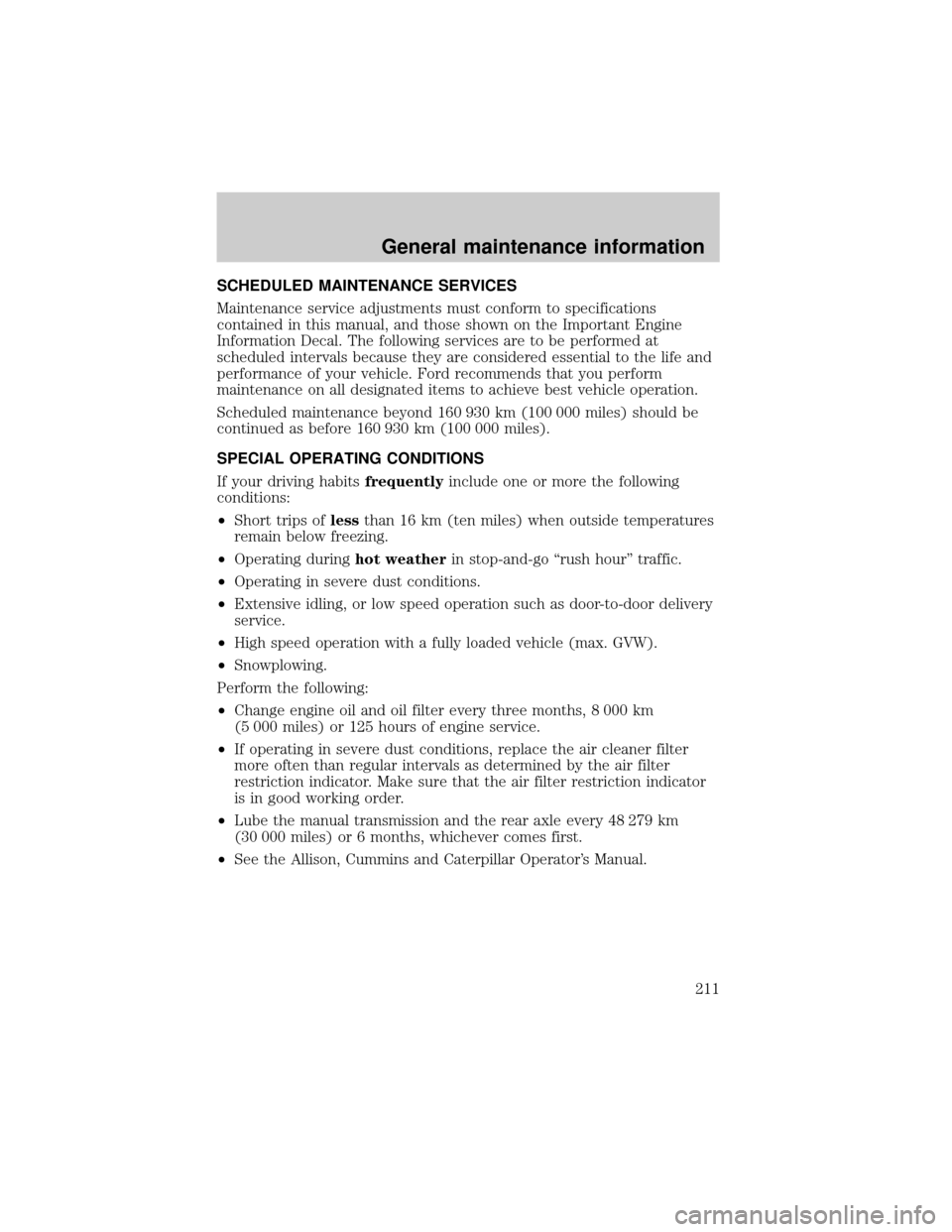
SCHEDULED MAINTENANCE SERVICES
Maintenance service adjustments must conform to specifications
contained in this manual, and those shown on the Important Engine
Information Decal. The following services are to be performed at
scheduled intervals because they are considered essential to the life and
performance of your vehicle. Ford recommends that you perform
maintenance on all designated items to achieve best vehicle operation.
Scheduled maintenance beyond 160 930 km (100 000 miles) should be
continued as before 160 930 km (100 000 miles).
SPECIAL OPERATING CONDITIONS
If your driving habitsfrequentlyinclude one or more the following
conditions:
²Short trips oflessthan 16 km (ten miles) when outside temperatures
remain below freezing.
²Operating duringhot weatherin stop-and-go ªrush hourº traffic.
²Operating in severe dust conditions.
²Extensive idling, or low speed operation such as door-to-door delivery
service.
²High speed operation with a fully loaded vehicle (max. GVW).
²Snowplowing.
Perform the following:
²Change engine oil and oil filter every three months, 8 000 km
(5 000 miles) or 125 hours of engine service.
²If operating in severe dust conditions, replace the air cleaner filter
more often than regular intervals as determined by the air filter
restriction indicator. Make sure that the air filter restriction indicator
is in good working order.
²Lube the manual transmission and the rear axle every 48 279 km
(30 000 miles) or 6 months, whichever comes first.
²See the Allison, Cummins and Caterpillar Operator's Manual.
General maintenance information
211
Page 212 of 240
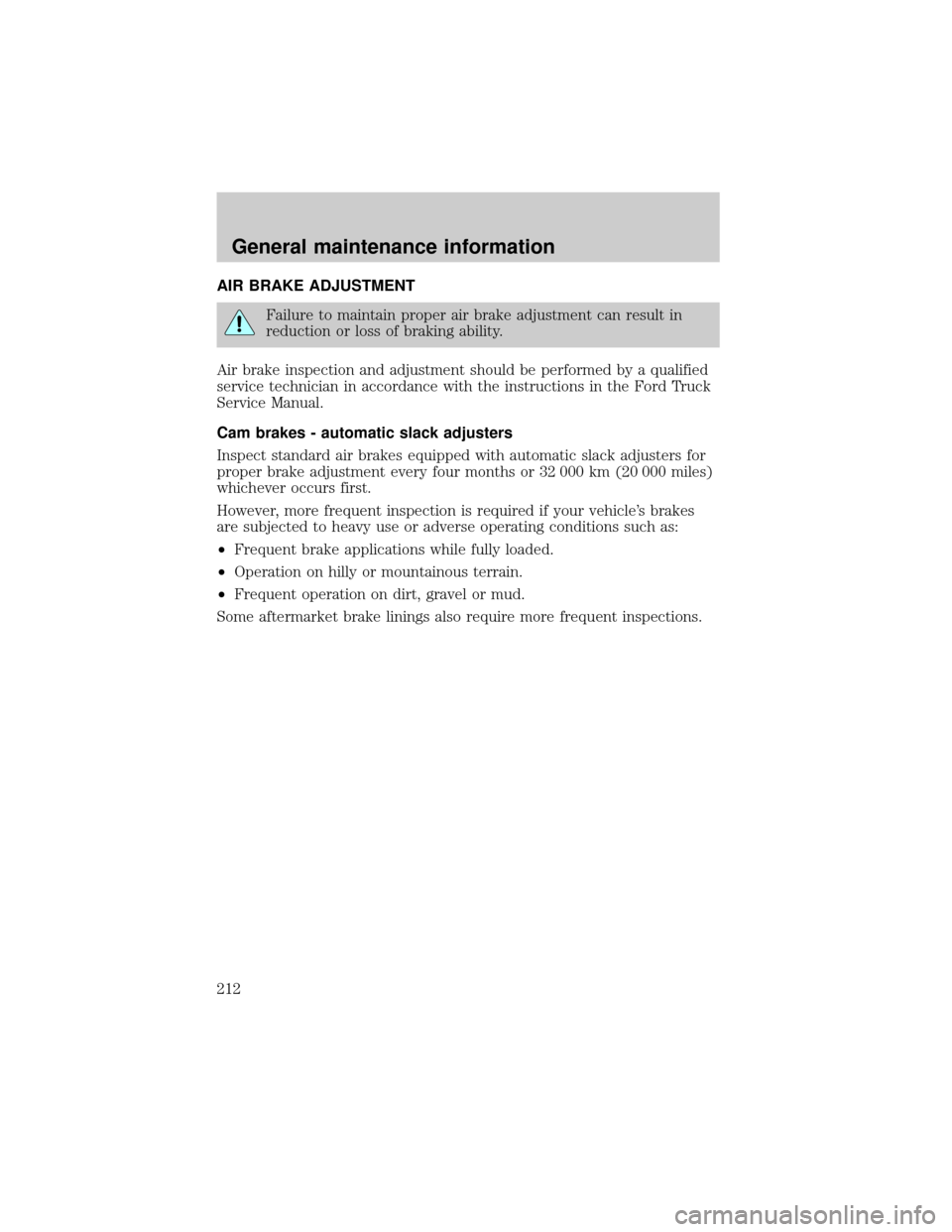
AIR BRAKE ADJUSTMENT
Failure to maintain proper air brake adjustment can result in
reduction or loss of braking ability.
Air brake inspection and adjustment should be performed by a qualified
service technician in accordance with the instructions in the Ford Truck
Service Manual.
Cam brakes - automatic slack adjusters
Inspect standard air brakes equipped with automatic slack adjusters for
proper brake adjustment every four months or 32 000 km (20 000 miles)
whichever occurs first.
However, more frequent inspection is required if your vehicle's brakes
are subjected to heavy use or adverse operating conditions such as:
²Frequent brake applications while fully loaded.
²Operation on hilly or mountainous terrain.
²Frequent operation on dirt, gravel or mud.
Some aftermarket brake linings also require more frequent inspections.
General maintenance information
212
Page 213 of 240
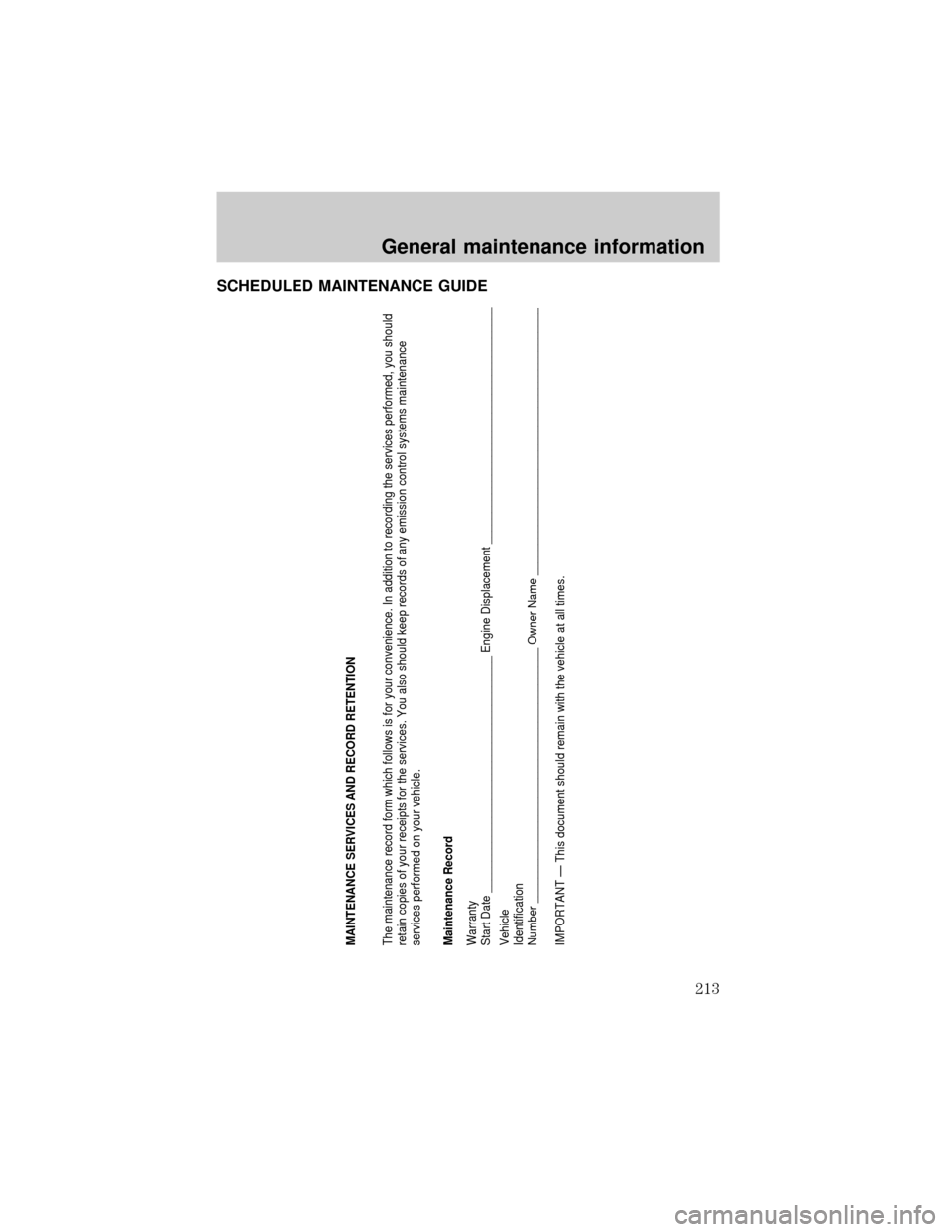
SCHEDULED MAINTENANCE GUIDE
MAINTENANCE SERVICES AND RECORD RETENTION
The maintenance record form which follows is for your convenience. In addition to recording the services performed, you should
retain copies of your receipts for the services. You also should keep records of any emission control systems maintenance
services performed on your vehicle.
Maintenance Record
Warranty
Start Date ______________________________________ Engine Displacement ______________________________________
Vehicle
Identification
Number _________________________________________ Owner Name ___________________________________________
IMPORTANT — This document should remain with the vehicle at all times.
General maintenance information
213
Page 214 of 240
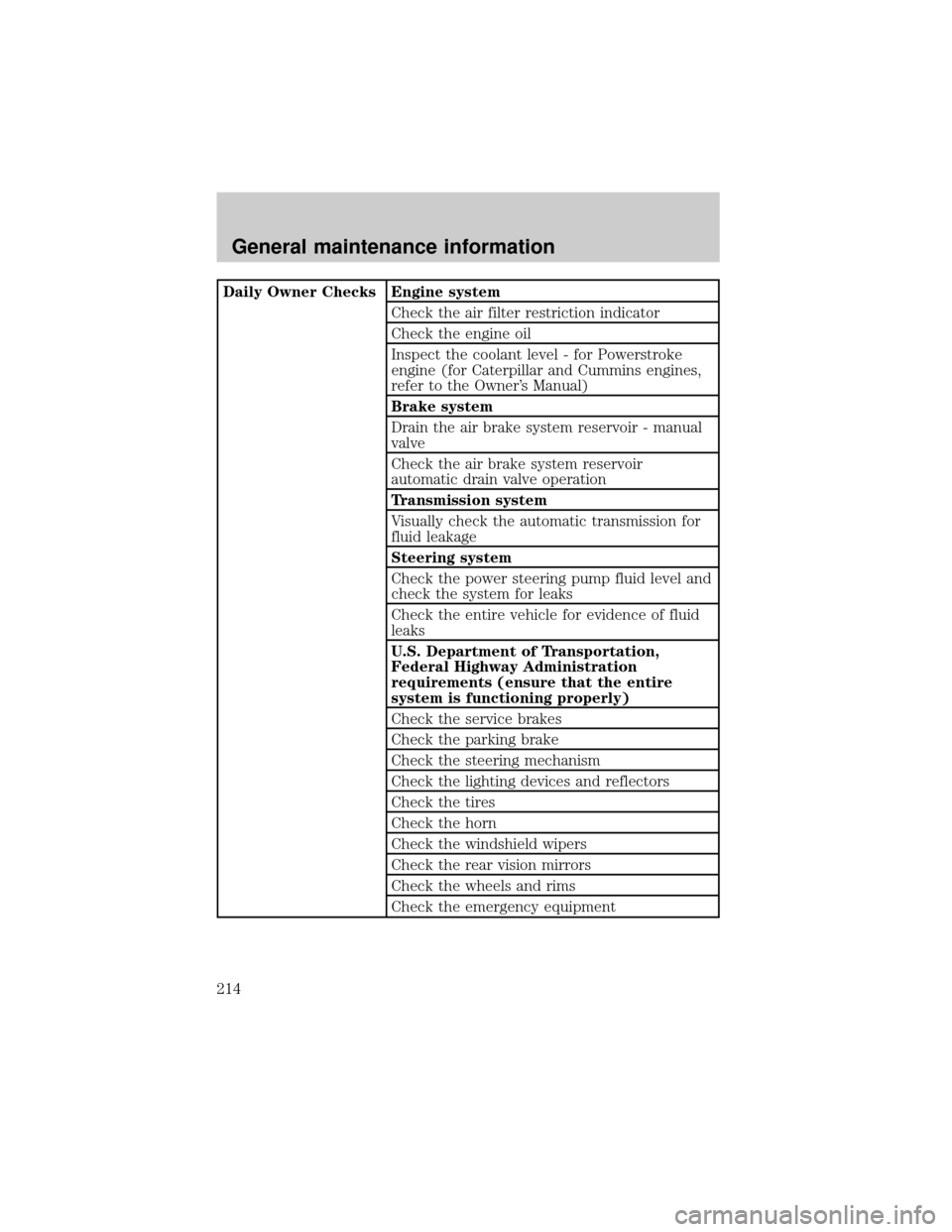
Daily Owner Checks Engine system
Check the air filter restriction indicator
Check the engine oil
Inspect the coolant level - for Powerstroke
engine (for Caterpillar and Cummins engines,
refer to the Owner's Manual)
Brake system
Drain the air brake system reservoir - manual
valve
Check the air brake system reservoir
automatic drain valve operation
Transmission system
Visually check the automatic transmission for
fluid leakage
Steering system
Check the power steering pump fluid level and
check the system for leaks
Check the entire vehicle for evidence of fluid
leaks
U.S. Department of Transportation,
Federal Highway Administration
requirements (ensure that the entire
system is functioning properly)
Check the service brakes
Check the parking brake
Check the steering mechanism
Check the lighting devices and reflectors
Check the tires
Check the horn
Check the windshield wipers
Check the rear vision mirrors
Check the wheels and rims
Check the emergency equipment
General maintenance information
214
Page 215 of 240
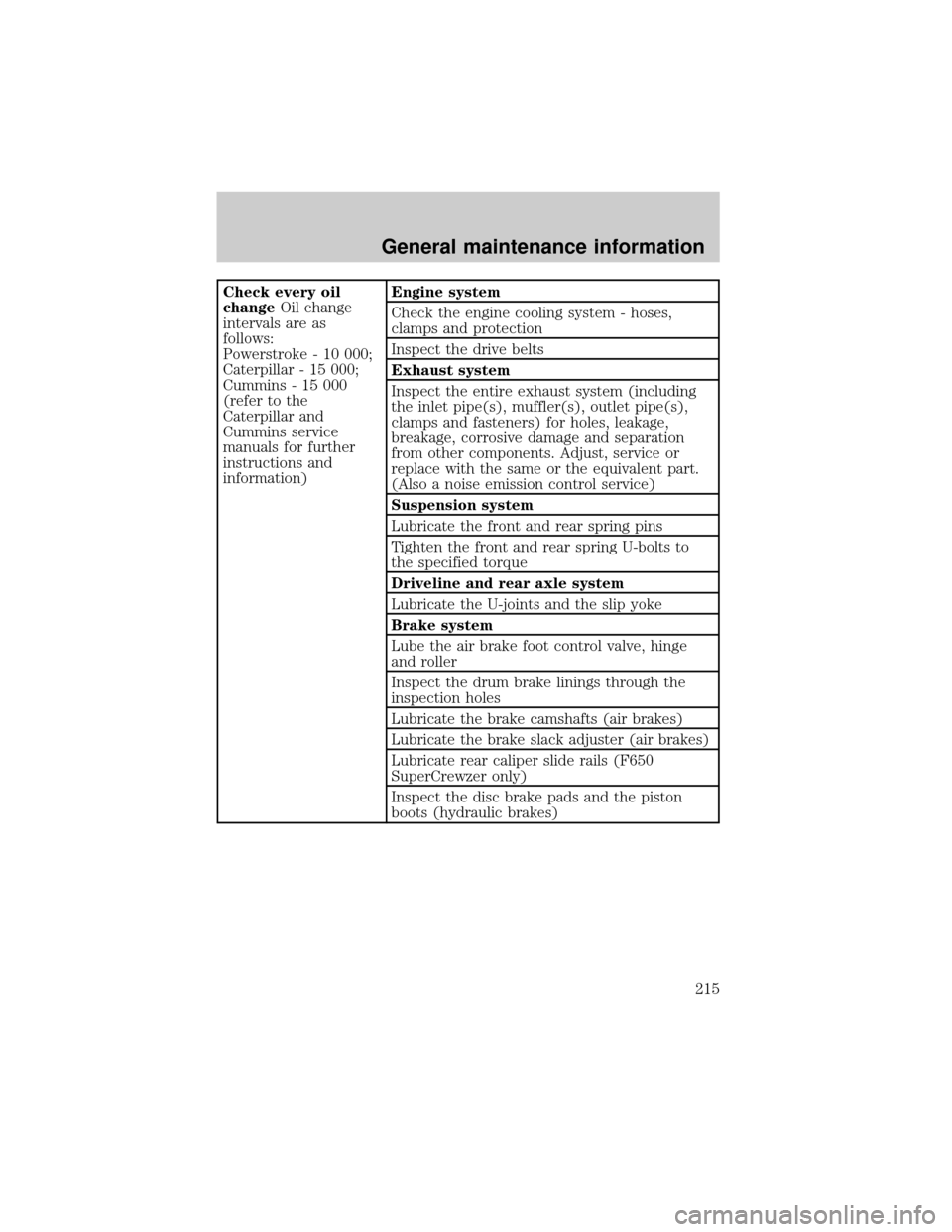
Check every oil
changeOil change
intervals are as
follows:
Powerstroke - 10 000;
Caterpillar - 15 000;
Cummins - 15 000
(refer to the
Caterpillar and
Cummins service
manuals for further
instructions and
information)Engine system
Check the engine cooling system - hoses,
clamps and protection
Inspect the drive belts
Exhaust system
Inspect the entire exhaust system (including
the inlet pipe(s), muffler(s), outlet pipe(s),
clamps and fasteners) for holes, leakage,
breakage, corrosive damage and separation
from other components. Adjust, service or
replace with the same or the equivalent part.
(Also a noise emission control service)
Suspension system
Lubricate the front and rear spring pins
Tighten the front and rear spring U-bolts to
the specified torque
Driveline and rear axle system
Lubricate the U-joints and the slip yoke
Brake system
Lube the air brake foot control valve, hinge
and roller
Inspect the drum brake linings through the
inspection holes
Lubricate the brake camshafts (air brakes)
Lubricate the brake slack adjuster (air brakes)
Lubricate rear caliper slide rails (F650
SuperCrewzer only)
Inspect the disc brake pads and the piston
boots (hydraulic brakes)
General maintenance information
215
Page 216 of 240
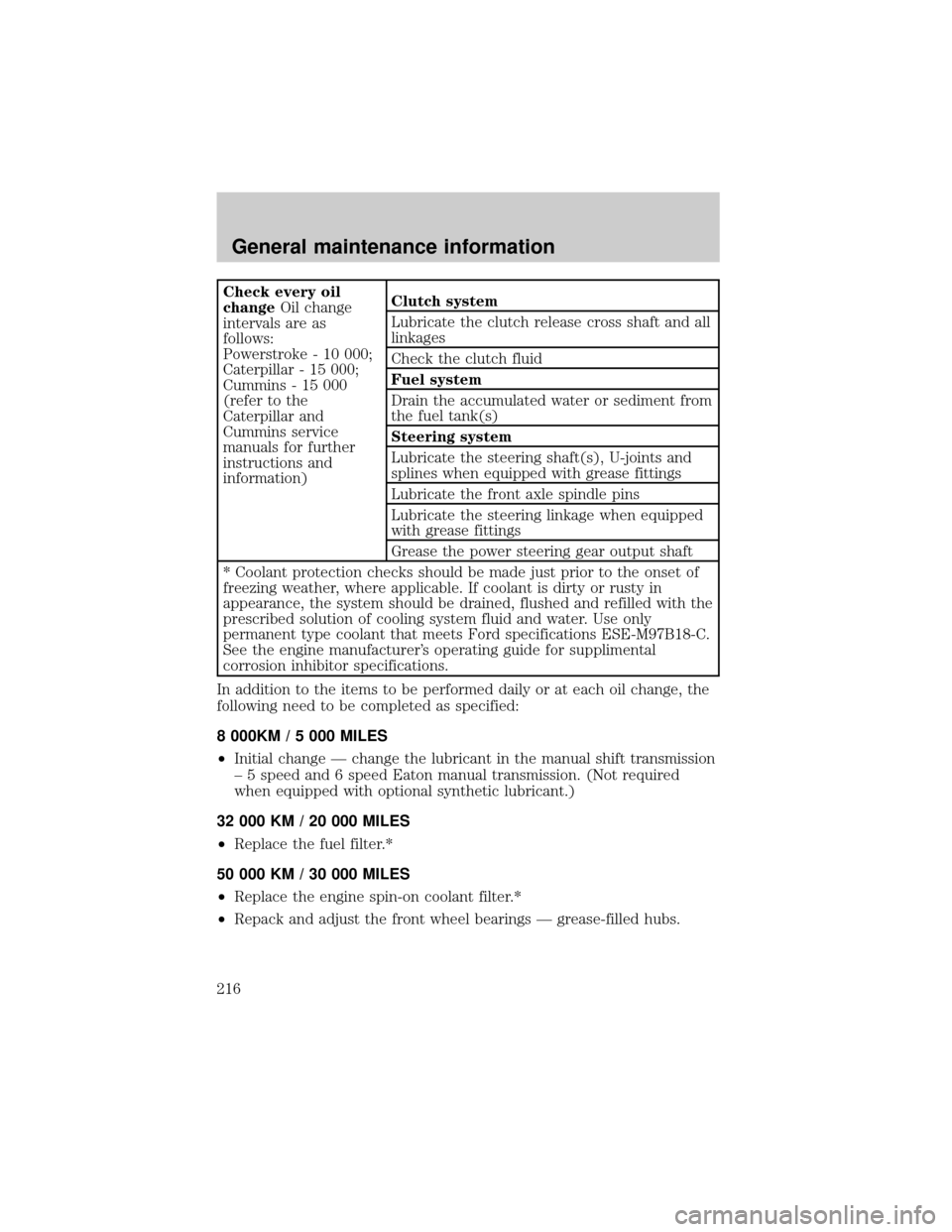
Check every oil
changeOil change
intervals are as
follows:
Powerstroke - 10 000;
Caterpillar - 15 000;
Cummins - 15 000
(refer to the
Caterpillar and
Cummins service
manuals for further
instructions and
information)Clutch system
Lubricate the clutch release cross shaft and all
linkages
Check the clutch fluid
Fuel system
Drain the accumulated water or sediment from
the fuel tank(s)
Steering system
Lubricate the steering shaft(s), U-joints and
splines when equipped with grease fittings
Lubricate the front axle spindle pins
Lubricate the steering linkage when equipped
with grease fittings
Grease the power steering gear output shaft
* Coolant protection checks should be made just prior to the onset of
freezing weather, where applicable. If coolant is dirty or rusty in
appearance, the system should be drained, flushed and refilled with the
prescribed solution of cooling system fluid and water. Use only
permanent type coolant that meets Ford specifications ESE-M97B18-C.
See the engine manufacturer's operating guide for supplimental
corrosion inhibitor specifications.
In addition to the items to be performed daily or at each oil change, the
following need to be completed as specified:
8 000KM / 5 000 MILES
²Initial change Ð change the lubricant in the manual shift transmission
± 5 speed and 6 speed Eaton manual transmission. (Not required
when equipped with optional synthetic lubricant.)
32 000 KM / 20 000 MILES
²Replace the fuel filter.*
50 000 KM / 30 000 MILES
²Replace the engine spin-on coolant filter.*
²Repack and adjust the front wheel bearings Ð grease-filled hubs.
General maintenance information
216
Page 217 of 240
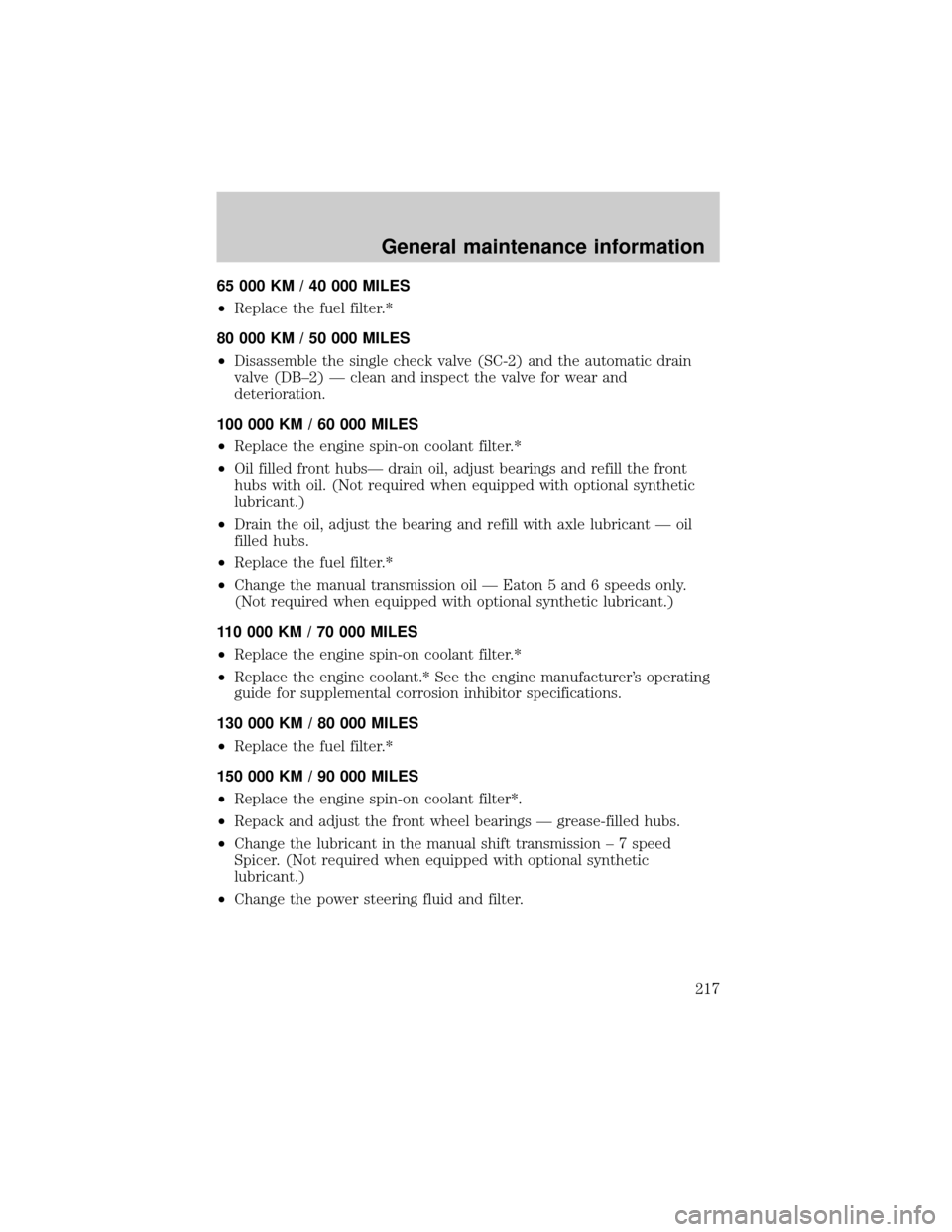
65 000 KM / 40 000 MILES
²Replace the fuel filter.*
80 000 KM / 50 000 MILES
²Disassemble the single check valve (SC-2) and the automatic drain
valve (DB±2) Ð clean and inspect the valve for wear and
deterioration.
100 000 KM / 60 000 MILES
²Replace the engine spin-on coolant filter.*
²Oil filled front hubsÐ drain oil, adjust bearings and refill the front
hubs with oil. (Not required when equipped with optional synthetic
lubricant.)
²Drain the oil, adjust the bearing and refill with axle lubricant Ð oil
filled hubs.
²Replace the fuel filter.*
²Change the manual transmission oil Ð Eaton 5 and 6 speeds only.
(Not required when equipped with optional synthetic lubricant.)
110 000 KM / 70 000 MILES
²Replace the engine spin-on coolant filter.*
²Replace the engine coolant.* See the engine manufacturer's operating
guide for supplemental corrosion inhibitor specifications.
130 000 KM / 80 000 MILES
²Replace the fuel filter.*
150 000 KM / 90 000 MILES
²Replace the engine spin-on coolant filter*.
²Repack and adjust the front wheel bearings Ð grease-filled hubs.
²Change the lubricant in the manual shift transmission ± 7 speed
Spicer. (Not required when equipped with optional synthetic
lubricant.)
²Change the power steering fluid and filter.
General maintenance information
217
Page 218 of 240

160 000 KM / 100 000 MILES
²Disassemble the single check valve (SC-3) and the automatic drain
valve (DB±2) Ð clean and inspect the valves for wear and
deterioration.
²Lube the clutch release and the cross shaft lever.
²Replace the fuel filter.*
²Change the rear axle lubricant. (Not required when equipped with
optional synthetic lubricant.)
400 000 KM / 250 000 MILES
²Change the rear axle lubricant when equipped with optional synthetic
lubricant.
500 000 KM / 300 000 MILES
²Disassemble the air dryer, replace the desiccant and check the
mounting of the dryer to the vehicle (if equipped).
Please continue with these scheduled maintenance intervals for your
vehicle.
* Shown intervals are for Powerstroke engine only. Refer to Caterpillar
and Cummins Owner Manuals for intervals for their respective engines.
General maintenance information
218
Page 219 of 240
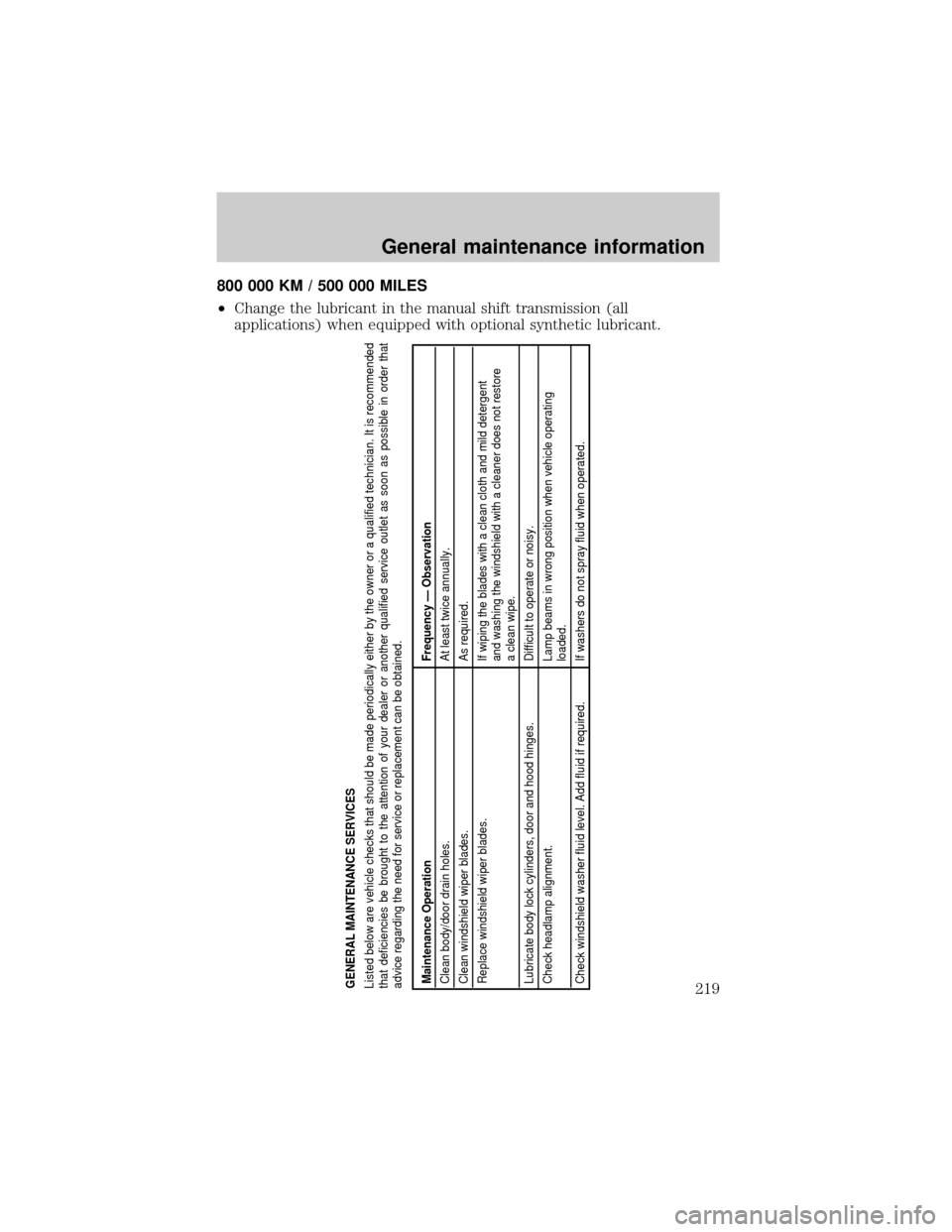
800 000 KM / 500 000 MILES
²Change the lubricant in the manual shift transmission (all
applications) when equipped with optional synthetic lubricant.
Maintenance Operation Frequency — ObservationClean body/door drain holes.
Clean windshield wiper blades.
Replace windshield wiper blades.
Lubricate body lock cylinders, door and hood hinges.
Check headlamp alignment.
Check windshield washer fluid level. Add fluid if required.At least twice annually.
As required.
If wiping the blades with a clean cloth and mild detergent
and washing the windshield with a cleaner does not restore
a clean wipe.
Difficult to operate or noisy.
Lamp beams in wrong position when vehicle operating
loaded.
If washers do not spray fluid when operated. GENERAL MAINTENANCE SERVICES
Listed below are vehicle checks that should be made periodically either by the owner or a qualified technician. It is recommended
that deficiencies be brought to the attention of your dealer or another qualified service outlet as soon as possible in order that
advice regarding the need for service or replacement can be obtained.
General maintenance information
219
Page 220 of 240
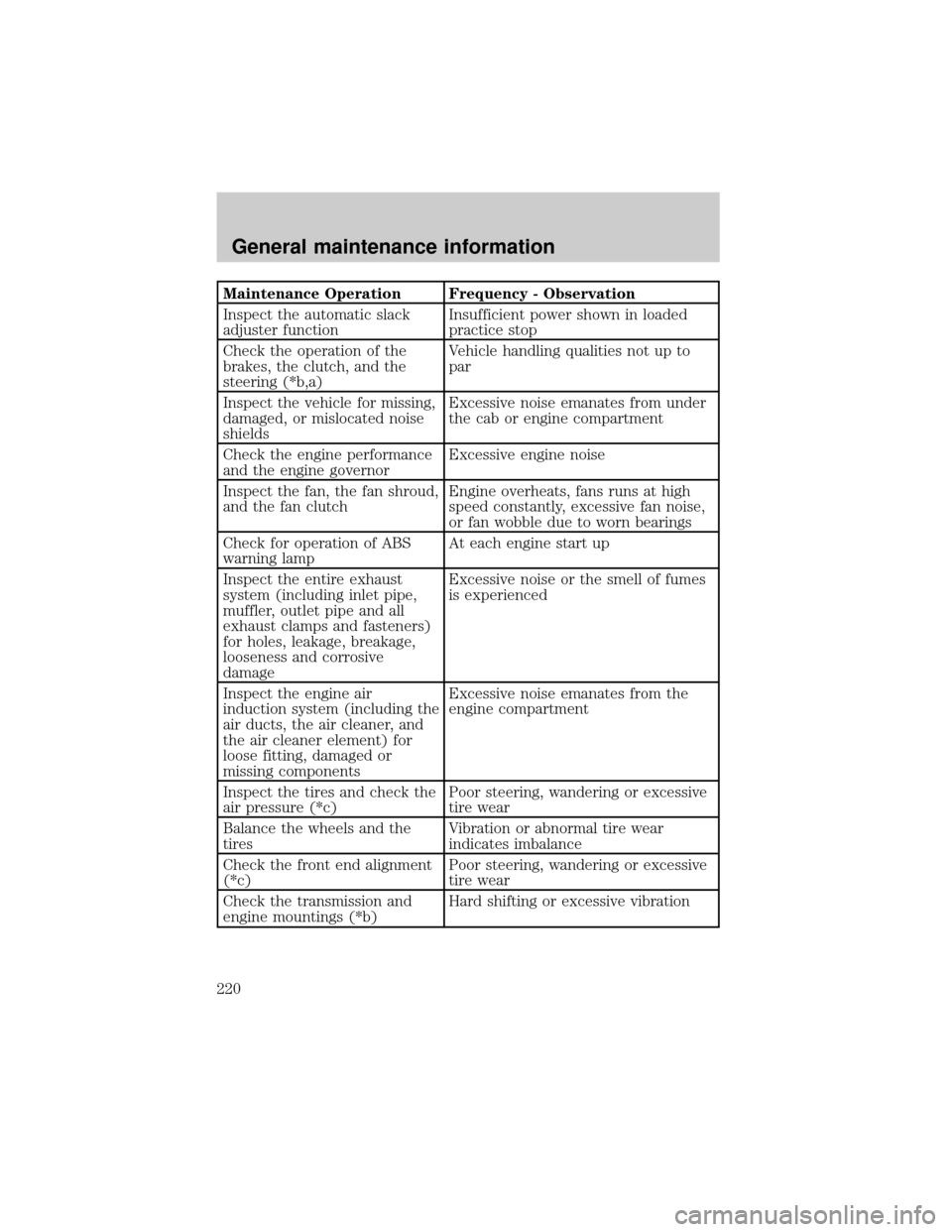
Maintenance Operation Frequency - Observation
Inspect the automatic slack
adjuster functionInsufficient power shown in loaded
practice stop
Check the operation of the
brakes, the clutch, and the
steering (*b,a)Vehicle handling qualities not up to
par
Inspect the vehicle for missing,
damaged, or mislocated noise
shieldsExcessive noise emanates from under
the cab or engine compartment
Check the engine performance
and the engine governorExcessive engine noise
Inspect the fan, the fan shroud,
and the fan clutchEngine overheats, fans runs at high
speed constantly, excessive fan noise,
or fan wobble due to worn bearings
Check for operation of ABS
warning lampAt each engine start up
Inspect the entire exhaust
system (including inlet pipe,
muffler, outlet pipe and all
exhaust clamps and fasteners)
for holes, leakage, breakage,
looseness and corrosive
damageExcessive noise or the smell of fumes
is experienced
Inspect the engine air
induction system (including the
air ducts, the air cleaner, and
the air cleaner element) for
loose fitting, damaged or
missing componentsExcessive noise emanates from the
engine compartment
Inspect the tires and check the
air pressure (*c)Poor steering, wandering or excessive
tire wear
Balance the wheels and the
tiresVibration or abnormal tire wear
indicates imbalance
Check the front end alignment
(*c)Poor steering, wandering or excessive
tire wear
Check the transmission and
engine mountings (*b)Hard shifting or excessive vibration
General maintenance information
220